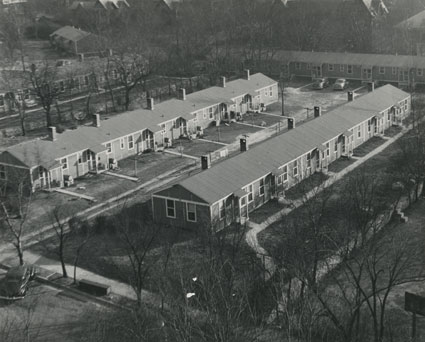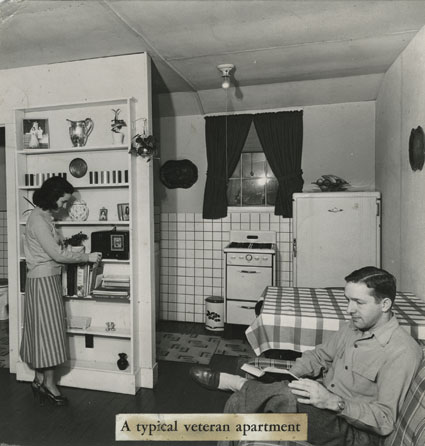
The G.I. Bill changed the way the state and its citizens thought about one another in the postwar period. This was seen especially in regard to higher education, which quickly emerged as one of the institutional embodiments of the G.I. Bill. With an estimated 1.5 million college-student school years lost to military service, and with national enrollment stuck at half its prewar level, a record windfall of veterans on college campuses precipitated an unparalleled period of expansion in American higher education. In 1947-48 veterans totaled nearly 50 percent of college students nationwide. At the University of Michigan, for example, better than half of the 20,000 undergraduates were veterans, and by 1949 nearly 2.5 million Americans were in college—1 million more students than in any single year prior to World War II.
Though several university presidents agreed with Robert M. Hutchins, president of the University of Chicago, who predicted that returning soldiers would turn American colleges into “hobo jungles,” nothing of the sort occurred. Rather, by most accounts veteran students in many ways improved the quality of American higher learning. Veterans were older, often married with children, and eschewed the high-jinks and “rah-rah” behavior of their younger peers. They dismissed Greek life as well as the traditions of in loco parentis, providing ample evidence that the American college was a place for “adults” as well as “children.” Traditional undergraduates complained about the seriousness with which veterans approached their educations. “All they care about is their school work,” fumed an exasperated undergraduate. “They’re grinds, every one of them. It’s books, books all the time.” College administrators thought otherwise. They credited veterans for helping to cultivate a more rigorous and disciplined academic and social culture—a few even went so far as to proclaim them the “best” single cohort of students ever enrolled in American higher education. By the turn of the twenty-first century, this heroic narrative was not only etched in stone, but also permeated popular culture and academic histories. Books, films and miniseries all celebrated the G.I.-Bill-wielding veteran as the heart and soul of America’s so called “greatest generation.”
While the G.I. Bill certainly was great for many white male veterans—the quintessential “adjusted” citizen—the legislation had a far more modest impact on other segments of the veteran population. By design the means-test for accessing the G.I. Bill was simple: a minimum of ninety days of continuous service and a discharge other than a dishonorable one. These criteria automatically barred dishonorably discharged homosexual veterans. Nothing on paper made the systematic exclusion of African Americans and females a foregone conclusion, but the G.I. Bill’s decentralized administrative structure combined with entrenched, often legal discriminatory practices by banks and colleges prevented millions of Americans from tapping the benefits due them. Although many women enjoyed the privileges of the G.I. Bill by way of marriage, fewer than 3 percent of all female veterans actually made use of the legislation in their own name. And African-American veterans found the G.I. Bill’s rewards still more elusive. To preserve their segregated racial order, southern Democrats fought mightily—at one point threatening to altogether derail the legislation—in order to ensure that the Veterans Administration disbursed G.I. Bill home and business loans and educational aid through private lending agencies and semiautonomous higher education institutions and training centers. This decentralized administrative approach reinforced bigoted appraisal practices in the North and South, and prevented all but the most determined African-American veterans from receiving the federally insured loans promised them. An Ebony study highlighted the near-insurmountable challenges of this localized distribution model, discovering that black veterans in thirteen Mississippi cities only secured 2 of the 3,229 loans approved by the Veterans Administration during the summer of 1947. One observer, himself a black veteran, commented, “To Negro veterans in Mississippi getting a G.I. loan is similar to seeking ‘The Holy Grail.’”
College going proved equally challenging for black veterans. Inadequate preparatory training and racist college admission systems largely prevented African-American veterans from enrolling in the nation’s elite schools, forcing them instead to pursue their educational aspirations at vocational schools or at historically black institutions of higher learning. Unfortunately, the country’s small network of black colleges and universities was unprepared for the flood of veteran applicants, and an estimated twenty thousand African-American veterans were denied admission because of the lack of institutional capacity. In spite of these obstacles, and in large part thanks to the G.I. Bill, African-American colleges, consistent with the experiences of other higher education institutions, achieved double-digit enrollment increases in the postwar period, educating a record seventy-five thousand students in 1950. Many African-American veterans returned from the war convinced higher learning was necessary for full democratic citizenship.
For psychological and economic reasons, state policymakers and academic leaders agreed veterans should be granted special educational opportunities as a reward for their wartime service. But soldiers were not the only Americans who served and sacrificed during the war. On the home front, the state asked Americans not only to endure the absence and death of loved ones, but also to tolerate rationing, price and wage controls, and tax increases that exacted their own emotional and financial toll. For the most part the civilian population willingly obliged the state’s various demands: families planted “victory gardens,” bought war bonds, curbed gasoline use, cut back on common household consumables, and deprived themselves of personal fineries, including silk and cotton. These may have been trivial burdens in comparison to those experienced by most soldiers, but that did not prevent many civilians from exiting the war convinced that they had contributed to victory and now deserved their fair share of the spoils. “Americans,” one historian has concluded, “had begun during the war to look to the federal government for guarantees of growing economic opportunity, not just rescue from the Depression.”
In this respect the G.I. Bill proved vitally important as a policy touchstone. It whetted Americans’ appetites for education and cemented a reciprocal relationship between higher education and the state that irrevocably altered both institutions in a number of ways over the course of the following decades. First, the state made both active duty education programming and the G.I. Bill permanent policy tools. Subsequent incarnations of the G.I. Bill were less bountiful. But the reformulation of military service as an extension of civilian life—replete with material and educational entitlements for service personnel—endured and permanently changed the way the U.S. armed services marketed themselves to America’s young men and women. Not even the debacle of the Vietnam War, which seriously tested the state’s commitment to its veterans, came close to undermining higher education’s role in sustaining the citizen-soldier tradition forged in the crucible of World War II.

Second, the state extended the promise of the G.I. Bill of Rights by helping elevate higher education as a right of democratic citizenship independent of military service. Policy statements crafted by the Truman administration played a pivotal role in this development. In 1947 the historic publication of the widely influential To Secure These Rights: the Report of the President’s Committee on Civil Rights provided one of the most devastating indictments ever of racial inequality in America. The committee demanded that the federal government vigorously act to guarantee all Americans’ right to safety and security, to freedom of conscience and expression, to equality of opportunity—that is, to full democratic citizenship and its privileges. The report described the persistence of racial segregation and discrimination, not only in the South but everywhere, as beyond shameful, describing in painful detail the moral, economic, and international costs of America’s “history of bigotry.” The committee challenged the federal government to protect racial minorities against “the crime of lynching” and to end discrimination in voting and employment, in housing and military service, and not least of all, in education. Here the report highlighted citizens’ right to education—including higher education—as a core recommendation. Equal educational opportunity had long been a demand of civil rights activists, but their traditional focus had been on equalizing elementary and secondary rather than higher education. To Secure These Rights changed that.
“College administrators credited veterans for helping to cultivate a more rigorous and disciplined academic and social culture—a few even went so far as to proclaim them the ‘best’ single cohort of students ever enrolled in American higher education.”
Only weeks after the release of the civil rights report, the President’s Commission on Higher Education unveiled Higher Education for American Democracy, which advanced the state’s growing claim on higher education policymaking in the postwar era. The Truman Report, as it was often called, offered a bold defense of higher education as important for the psychosocial development of the individual, for a more robust and informed public sphere, for international understanding, and for creative solutions to the nation’s and the world’s most vexing problems. The report reaffirmed the call of the Committee on Civil Rights for an end to segregated colleges, universities, and professional schools. And it also endorsed a bevy of other federal initiatives, including a national program of scholarships and fellowships, direct financial support for campus building projects, a new cabinet-level Department of Education, greater support of adult education, and a doubling of the nation’s higher education enrollment (to nearly 5 million) within the decade.
With the exception of desegrating the military, which occurred via executive order in 1948, the other promises listed in the civil rights and higher education reports remained unfulfilled until the 1960s. Even so, the egalitarian message embedded in both documents (along with the creation of the National Science Foundation in 1950) helped put higher education on the nation’s political agenda in a most visible way. The belief that millions more Americans—white and black, young and old—were not only deserving but capable of at least some advanced study fueled widespread interest in the so-called “democratization” of higher education during the 1950s. The continued growth of college enrollments, the steady expansion of the junior college sector, and the introduction of educational television suggested that the government was serious about equalizing educational opportunities for all. Meanwhile, participation in the United Nations Educational, Scientific, and Cultural Organization (UNESCO) and the government’s enactment of the Fulbright educational exchange program, the Point IV Program, and other broadly construed academic exchange programs revealed that the state and higher education were interested in exporting America’s educational expertise to the rest of the world. By the close of World War II, American higher education had become democracy’s proving ground.